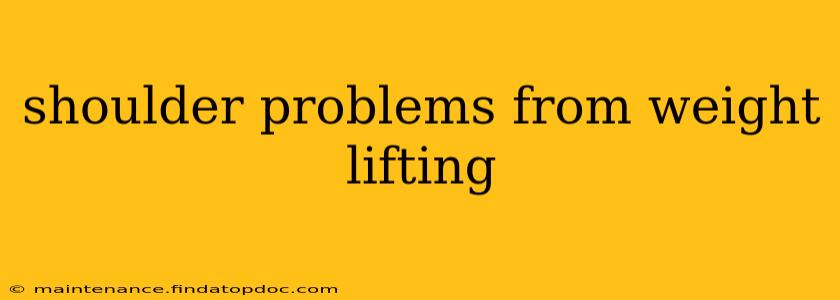Weightlifting, while offering incredible strength and fitness benefits, can unfortunately lead to shoulder problems if not approached correctly. Many lifters experience pain, discomfort, and decreased performance due to shoulder injuries. This comprehensive guide delves into the common causes, symptoms, prevention strategies, and treatment options for shoulder problems stemming from weightlifting.
What are the common shoulder problems from weightlifting?
Several conditions can arise from improper weightlifting technique or excessive training. These include:
-
Rotator Cuff Injuries: The rotator cuff is a group of muscles and tendons that stabilize the shoulder joint. Overuse, improper form, or sudden impacts can lead to strains, tears, or tendinitis. This often manifests as pain, weakness, and limited range of motion.
-
Shoulder Impingement: This occurs when the tendons of the rotator cuff get compressed under the acromion bone (part of the shoulder blade). Repetitive overhead movements in weightlifting can contribute to impingement, causing pain, inflammation, and reduced mobility.
-
Labral Tears: The labrum is a ring of cartilage that provides stability to the shoulder joint. Heavy lifting, especially with poor form, can tear this cartilage, leading to pain, clicking, and instability.
-
Acromioclavicular (AC) Joint Injuries: This joint connects the collarbone (clavicle) to the shoulder blade (scapula). Weightlifting can strain or sprain this joint, resulting in pain and tenderness at the top of the shoulder.
-
Biceps Tendonitis: The biceps tendon can become inflamed from repetitive lifting, leading to pain in the front of the shoulder, particularly during lifting or reaching.
What are the symptoms of shoulder problems from weightlifting?
Symptoms vary depending on the specific injury but can include:
- Pain: This is the most common symptom, ranging from mild aching to severe sharp pain. Pain can be felt during lifting, at rest, or even at night.
- Weakness: Difficulty lifting weights or performing daily tasks.
- Limited Range of Motion: Inability to fully raise, lower, or rotate the arm.
- Swelling: Inflammation around the shoulder joint.
- Stiffness: Difficulty moving the shoulder freely.
- Clicking or Popping: Sounds from the shoulder joint during movement.
How can I prevent shoulder problems from weightlifting?
Prevention is key! Here are some crucial strategies:
- Proper Warm-up: Always start with a dynamic warm-up that includes shoulder rotations, arm circles, and other exercises to prepare the muscles and joints for lifting.
- Correct Form: Focus on maintaining proper form throughout each lift. Consult with a qualified trainer to ensure your technique is correct. Slow and controlled movements are better than fast, jerky ones.
- Progressive Overload: Gradually increase the weight and intensity of your workouts to avoid overwhelming your shoulders.
- Adequate Rest and Recovery: Allow your muscles and joints sufficient time to recover between workouts. Overtraining is a major risk factor for injury.
- Strengthening Supporting Muscles: Focus not just on the muscles directly involved in the lifts but also on the supporting muscles of the rotator cuff and scapular stabilizers. Exercises like external and internal rotations, scapular retractions, and face pulls are crucial.
- Listen to Your Body: Pay attention to pain signals. If you feel pain, stop the exercise and rest. Ignoring pain can lead to more serious injuries.
How are shoulder problems from weightlifting treated?
Treatment depends on the severity of the injury:
- Rest and Ice: For mild injuries, rest, ice, and over-the-counter pain relievers may be sufficient.
- Physical Therapy: A physical therapist can guide you through exercises to strengthen your shoulder muscles, improve range of motion, and restore function.
- Medication: In some cases, your doctor may prescribe anti-inflammatory medication or pain relievers.
- Corticosteroid Injections: These injections can reduce inflammation and pain, but they are not a long-term solution.
- Surgery: Surgery may be necessary for severe injuries, such as a significant rotator cuff tear or labral tear.
What exercises can I do to strengthen my shoulders for weightlifting?
Focus on exercises that target the rotator cuff and scapular stabilizers. These include:
- External Rotations: Using resistance bands or dumbbells.
- Internal Rotations: Using resistance bands or dumbbells.
- Scapular Retractions: Squeezing your shoulder blades together.
- Face Pulls: Using a resistance band or cable machine.
- Overhead Press (with proper form): Focus on controlled movements and avoid excessive weight.
Can you explain the difference between a rotator cuff tear and impingement?
While both rotator cuff tears and impingement involve the rotator cuff tendons, they are distinct conditions. Impingement involves compression of the tendons under the acromion bone, often leading to inflammation and pain. A rotator cuff tear involves an actual tear in one or more of the rotator cuff tendons, resulting in more significant pain, weakness, and potentially loss of function.
How long does it take to recover from a shoulder injury sustained while weightlifting?
Recovery time varies greatly depending on the severity of the injury, the individual's healing capacity, and the adherence to the treatment plan. Minor strains might heal within a few weeks, while more significant tears may require months or even surgery and extended rehabilitation.
This information is for general knowledge and does not constitute medical advice. Always consult with a healthcare professional or qualified physical therapist for diagnosis and treatment of any shoulder pain or injury. They can provide personalized recommendations based on your specific situation. Remember, prioritizing proper form, progressive overload, and adequate recovery is crucial for safe and effective weightlifting.
